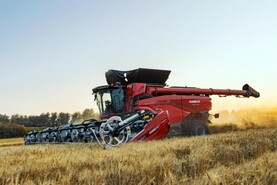Very shortly, we’ll begin the 310th Potterton harvest at Rathcormick. On 28 July 1710, a long lease on this farm was granted to John Potterton, then aged 35. Grain yields back then were depressingly low and it would be another 50 years before commercial agriculture would have a shake-up to feed rapidly growing and insatiable demand in Industrial Revolution England.
In the 1700s, rotation-wise, it would have been a very simple system, probably wheat following a fallow and then three crops of spring cereals. Not that there was much wrong with this.
This year, as it happens, we have a crop of wheat following a fallow and it’s the best-looking crop we have. It would make you think again about cover crops – sometimes the land needs a rest.
According to Arthur Young, the agricultural guru of the late 1700s, the Norfolk four-course rotation of turnips, spring barley, clover ley and winter wheat, the regenerative agriculture of its day, was not widely practised in Ireland. But like regenerative farming today, I’m sure it had its followers.
As for direct drills, there was none but Jethro Tull had invented the seed drill in 1701 but it surely was a type of min-till with shallow ploughing and minimal cultivations.
Nowadays, we’re saturated with break crops in the form of beans, oilseed rape (OSR) and, yes, oats
For it would take a good pair of oxen to pull a plough at more than four inches in our land. Draught horses would supersede oxen later on.
Though maybe the early Pottertons were exponents of the lesser-known Kildalkey rotation of wheat, oats, wheat, oats, which I practised for years. But, ultimately, it appears like everything else in the 1990s, it wasn’t sustainable as the oat mosaic virus became a problem and that finished the oats and I went to continuous wheat. Nowadays, we’re saturated with break crops in the form of beans, oilseed rape (OSR) and, yes, oats.
And this year is a case in point, which will make for quite a different harvest. It is roughly divided into three one-third sections. The first third of the harvest is winter barley, oats and winter OSR and should be now in July.
The second third is in August and that’ll be the winter wheat. The final third will be mid- to late September with spring OSR and beans. So it will be a long, drawn-out affair, even with good weather, just like it was in 1710.
Sterile brome
It’s been a problem year for the grassweed, sterile brome. The herbicide Pacifica has given mixed results in terms of chemical control.
I sprayed out bad patches in wheat with glyphosate six weeks ago, I’ve mowed, baled and dumped a couple of very badly infested spots and we resorted to some hand-rogueing. But this still leaves too much brome in two fields, in particular, which will have to revert to spring cereals (or even one of JP’s fallows) for a couple of years. Pity, because they were destined for a return to continuous wheat.
There’s an awful lot of talk about blackgrass which, thankfully, I haven’t seen here – yet. But brome is almost as pernicious with very hit-and-miss chemical control, like blackgrass, with no control options at all in winter barley.
We will have to resort to cultural control with spring cropping preceded by stale seedbeds sprayed off with glyphosate. This will substantially reduce infestations of both brome and blackgrass. I’ve done it before.
I doubt if the bould John Potterton was too worried about these grassweeds. I think wild oats were more his problem. Sowing them, that is…






 This is a subscriber-only article
This is a subscriber-only article










SHARING OPTIONS: